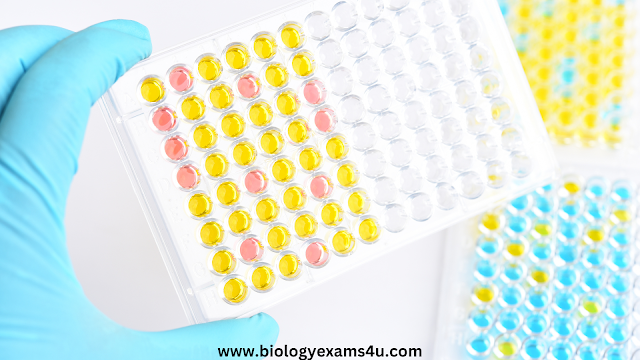(Enzyme Linked Immunosorbent Assay)
ELISA is an assay for quantifying either antibody or antigen by using an enzyme linked antibody and a substrate that forms a coloured reaction product. A number of enzymes have been employed for ELISA, including alkaline phosphatase, horseradish peroxidase and beta galactosidase. Different types of ELISA have been developed. Each type can be used qualitatively to detect the presence of antibody or antigen.

Some of the common types are the following.
(1) Indirect ELISA-Serum, or some other sample, containing primary antibody (Ab) is added to an antigen-coated moicrotiter well and allowed to react with the antigen attached to the well. The free antibody(ab,) is washed away and the presence of antibody, bound to the antigen, is detected by adding an enzyme-conjugated secondary anti-isotype antibody (Ab,)which binds to the primary antibody. Any free Ab, is washed away and a substrate for the enzyme is added. The amount of coloured reaction product that forms is measured by spectrophotometry. Indirect ELISA is the method of choice to detect the presence of serum antibodies against HIV. This method is often called direct antigen coating or DAC ELISA.
(2) Sandwich ELISA-In this technique, the antibody is immobilized on a microtiter well. A sample containing antigen is added and allowed to react with the the immobilized antibody. After the well is washed a second enzyme linked antibody specific for a different epitope on the antigen is added and allowed to react with the bound antigen. The unreacted second antibodies are removed by washing the substrate of the enzyme is added, and the coloured reaction product is measured. This technique is also called double antibody sandwich ELISA (DAS ELISA).
(3) Competitive ELISA- In this technique, antibody is first incubated in solution with a sample containing antigen. The antigen-antibody mixture is then added to an antigen-coated microtiter well. The more antigen present in the sample, the less would be the availability of free antibody to bind to the antigen-coated well. Addition of an enzyme-conjugated secondary antibody (Ab,), specific for the isotype of the primary antibody, can be used to determine the amount of primary antibody bound to the well as in indirect ELISA.
.png)
Uses: ELISA can be applied for the determination of the serum antibody concentrations in virus tests (such as HIV test). Applications of ELISA is important in home pregnancy test, in the detection of potential food allergens, such as milk, peanuts, walnuts, almonds, and eggs, in food industry, and also in toxicological tests for certain classes of drugs. ELISA was widely used in various of areas, such as immunology, biological pharmacy, diagnostic industry, and so on.

.png)
.png)